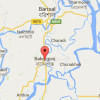Nature Quest: Guardian tree of Faridpur

Caught in the mosaic of day-to-day concerns, it's not always that one can appreciate the bigger picture: how much the future is with us, how the past endures. But in Ramkhondo village in Kanazipur union of Faridpur sadar upazila, there is a place where it's hardly possible not to feel one's relative insignificance within a grander scheme. In a field is a centenarian hijol tree standing as continuity's sentinel, offering gifts of beauty and of contemplation.
A signboard informs the visitors that the tree is a hundred years old.
"This tree is a kind of guardian," says one local, Omar Ali, 60. "It brings many benefits and we are proud of it." It's a tree that's old enough to have attracted superstition. If anyone cuts a branch of this tree, Omar adds, both the person and their family will suffer.
The hijol is a species well-suited to wetlands, often growing in haor-areas where the tree's trunk is submerged for several months each year. Hijol trees provide good shelter for migratory and other bird species, along with other types of animals hoping to escape the monsoon deluge. Its seeds are a traditional remedy for headaches, tumours and fungal infections. Its bark is known to help with coughs and rheumatism. Hijol wood is also used for boat building.
"I don't know who planted the tree or if it just grew naturally," says another 65-year old elderly local, Hatam Mollah. "But my father told me he also saw this tree in the same condition, so it must be old. Our family used to own the land on which the tree is situated, but now we don't. The forest office takes care of the tree." He says up to 100 people per day visit the hijol tree, which is twenty-five feet high and has a trunk of fourteen-foot diameter.
According to another villager, Mithun Kumar Das, many locals make good use of the tree. "People use its seed and bark for medicinal purposes," he says. "We want the government to take steps to make this a tourist spot and ensure the tree's preservation. I hope that it will survive for many more years."
"I've never seen a hijol tree like this one," says one visitor, Jahirul Hossain from Bowtipara village in adjacent Nagarkanda upazila. "So I came to see it. It's really amazing. It's a tree for everyone."
"There aren't many centurion trees in our country," says Maksudur, district president of a conservation organisation. "The government should care for this tree and all the old trees that remain. We should also generate public awareness to protect the tree."
The chairman of Kanaipur union council, Fokir Baylayat Hossain, doesn't need much convincing. "This hijol tree is a hundred years old and it is an asset to our locality. I want the government to develop the site for tourism."
Faridpur's divisional officer of the social forest division Md Anamul Haque is likewise to be counted among the tree's many admirers. "It's an asset not only locally but a national asset," he says. "Old trees like this one transpire huge amounts of water through their leaves which contributes to rainfall. They provide oxygen, improving air quality. They protect the soil and support wildlife. Every effort should be made to preserve this tree."
The tree is seventeen kilometres from Faridpur town and five kilometres from the Kanaipur bus stop in front of Ramkhondo Government Primary School on the Dhaka to Khulna highway. From there, the way to the tree is well signposted.


 For all latest news, follow The Daily Star's Google News channel.
For all latest news, follow The Daily Star's Google News channel. 







Comments